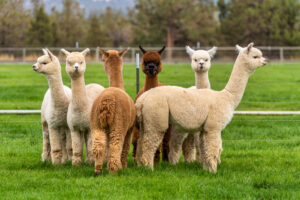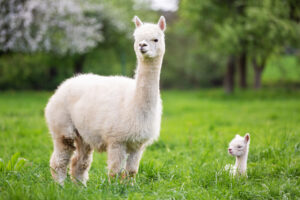***Take an extra 5% off products already on sale*, use code XTRA5 *Full details.
***Plus, FREE shipping sitewide!
Natural Alpaca Bedding
- posted by Tean
- | April 28, 2022
How Crescent Moon Alpaca Bedding Began
In 1997, Crescent Moon Llama Ranch in Kelowna, British Columbia, began producing comforters with the fleece from their 150 llamas. Julie McLean was hired to sew the comforters. In 2005, she would buy the manufacturing side of the company and transition it into a bustling bedding cut and sew shop, hiring many sewers to help make the comforters. They transitioned to using alpaca fiber after realizing it was much more plentiful and easier to process. While the business started out simply making comforters, they quickly expanded to include pillows and mattress pads/toppers. After 16 years of running the business, Julie was ready to retire. In the fall of 2021, she sold the business to Soaring Heart Natural Beds in Seattle. Soaring Heart was the perfect match for Crescent Moon Alpaca Bedding as they have been producing high quality organic mattresses and bedding since 1982.
Alpaca Bedding Products
 The Natural Sleep Store currently offers three products with alpaca fill by Crescent Moon. The Alpaca Wool Comforter, Alpaca Wool Mattress Topper, and Alpaca pillow. Wrapped in beautiful organic cotton, these products are filled with 70% alpaca fleece and 30% sheeps wool for a bit of added structure. The alpaca provides a much fluffier product than solely wool fill, similar to down. The Crescent Moon Alpaca Wool comforter provides great warmth with a light, lofty feel. To add a bit of softness and cushion to the top of your mattress, the Crescent Moon mattress topper adds about 2” of a soft airy feel. Lastly, the Crescent Moon Alpaca pillows come in three fill weights: soft, medium, and firm.
The Natural Sleep Store currently offers three products with alpaca fill by Crescent Moon. The Alpaca Wool Comforter, Alpaca Wool Mattress Topper, and Alpaca pillow. Wrapped in beautiful organic cotton, these products are filled with 70% alpaca fleece and 30% sheeps wool for a bit of added structure. The alpaca provides a much fluffier product than solely wool fill, similar to down. The Crescent Moon Alpaca Wool comforter provides great warmth with a light, lofty feel. To add a bit of softness and cushion to the top of your mattress, the Crescent Moon mattress topper adds about 2” of a soft airy feel. Lastly, the Crescent Moon Alpaca pillows come in three fill weights: soft, medium, and firm.
Using Alpaca in Bedding
 Nothing quite compares to the quality of alpaca. Alpaca has incredible moisture wicking properties. This naturally deters the build up of mold spores and mildew, which means your bedding stays fresh for longer and frequent cleaning is avoidable. Along with this, dust mites are dissuaded from your bedding. Decreasing the amount of common allergens in your bed is crucial for a peaceful night sleep. Alpaca is also all natural and chemical free. It is guaranteed to be free from harmful pesticides, unlike conventional cotton today. Unlike down, alpaca is a completely cruelty free fill. Alpaca provides the feel of down without any of the guilt. Alpaca bedding, if taken care of, holds its shape for a long time. Products with alpaca fill will last longer than other fills, and maintain amazing quality.
Nothing quite compares to the quality of alpaca. Alpaca has incredible moisture wicking properties. This naturally deters the build up of mold spores and mildew, which means your bedding stays fresh for longer and frequent cleaning is avoidable. Along with this, dust mites are dissuaded from your bedding. Decreasing the amount of common allergens in your bed is crucial for a peaceful night sleep. Alpaca is also all natural and chemical free. It is guaranteed to be free from harmful pesticides, unlike conventional cotton today. Unlike down, alpaca is a completely cruelty free fill. Alpaca provides the feel of down without any of the guilt. Alpaca bedding, if taken care of, holds its shape for a long time. Products with alpaca fill will last longer than other fills, and maintain amazing quality.
Alpaca Fleece
Alpaca fleece is a natural fiber which  comes from the alpaca. This renewable fleece is considered an animal protein fiber, like sheep’s wool. The microscopic structure of alpaca hair makes it significantly less scratchy than wool. It is also flame and water resistant. The fleece is a loose fiber, much less structured than wool. In addition, alpaca fur is hollow. This means air easily gets trapped inside, providing a light yet exceptionally warm product. Alpacas are shorned once a year in the spring. After they are shorned, the fleece is roughly cleaned and sorted according to color.
comes from the alpaca. This renewable fleece is considered an animal protein fiber, like sheep’s wool. The microscopic structure of alpaca hair makes it significantly less scratchy than wool. It is also flame and water resistant. The fleece is a loose fiber, much less structured than wool. In addition, alpaca fur is hollow. This means air easily gets trapped inside, providing a light yet exceptionally warm product. Alpacas are shorned once a year in the spring. After they are shorned, the fleece is roughly cleaned and sorted according to color.
History of the Alpaca
Alpacas, native to South America, have been domesticated for thousands of years. They were originally bred from the wild vicuna by indigenous tribes. Similar to the alpaca, the vicuna lives in the Andes mountains at a high altitude. They are a cousin to the camel, along with llamas. Alpacas have played a vital role in day to day life of the Andean and other indigenous peoples. Their value was first recognized by the Incan people. The animal became such a high commodity that Incan royalty and government quickly took tight control of the species. They were not only used for food, fuel, clothing, and transportation, but also played roles in important religious ceremonies. Alpacas thrived during this time, until the Spanish invasion in 1532 when 98% of the population was killed by invaders. Unlike the llama, alpacas are bred strictly for their coat, not to be working animals. Like camels, they are known to spit when unhappy, but will hum when content. Nowadays, alpacas have been brought from their native home to the U.S., New Zealand, and Australia.
Environmental Impact of the Alpaca
High quality fleece is not the only great thing about alpacas, they also have a minimal impact on the environment. Alpacas are one of the most eco friendly animals on the planet. They are very docile herbivores. While other animals eat tree bark and leaves, negatively affecting the tree population, alpacas prefer to graze on native grass. The grass is not pulled up by the roots, but nibbled off above ground. Unlike cattle and camels, they have padded feet. This means when they roam, no terrain is torn up or destroyed. Their three part stomach ensures low methane production, and they have pH neutral feces which serves as a great fertilizer.
